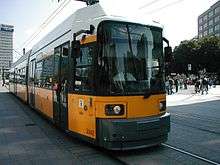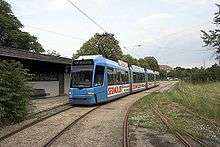ADtranz low floor tram

The ADtranz low floor tram was introduced in the 1990s as the world's first tram with a completely low floor. This tram was developed by MAN for the Bremen urban transport system. The prototype, tram number 3801, was first publicly introduced on 9 February 1990. From 1991 to 1993, it was tested in many European cities. Ten German cities have purchased this type. Adtranz took over the rail division of MAN in 1990.
The naming scheme is GTxN/M/S/K from German Gelenk-Triebwagen (articulated propelled railcar) with x axles for a specific gauge (Normalspur - standard gauge, Meterspur - meter gauge, Schmalspur - narrow gauge, Kapspur - cape gauge). Delivered models include the standard-gauge version that was named GT6N or GT8N and the metre-gauge version that was called GT6M.
ADtranz low floor trams come in lengths of three or four modules, all of which are approximately the same length. Under each module lies a bogie; the low floor, however, constrains the bogie's movement. Two of the axles are electrified linked to the bogie truck by means of a universal joint. Characteristic of this tram is its ability to follow curves, which requires a special track layout. This occurs when the first or last module drives through an arc and drags the other two modules (which are on the straight) after it.
First generation
The company Hansa Waggonbau in Bremen had been among the first to introduce the concept of articulated railcars which was delivered to customers with the GT4 model since 1959 (example) The fading interest in tram operation in the 1970s led to a bankruptcy of the company in 1975. Renewed interest in the concept sprang up in the late 1980s with Bremen and Munich to look for modernized versions of the GT type series. This included the wish for a low floor variant and all rail cars to be propelled. MAN took over the task to create a test model (number 561) in 1985 which had 3 units (instead of the 2 units of the GT4). The first model be on delivery (GT6N) was a three part electrical multiple unit (EMU) as well.
Tram operation includes:
- Augsburg: 12 GT6M
- Frankfurt (Oder): 8 GT6M
- Jena: 33 GT6M
- Mainz: 16 GT6M
- Zwickau: 12 GT6M
- Berlin: 150 GT6N
- Bremen: 78 GT8N
- Munich: 70 GT6N
- Norrköping: 4 GT6N (bought from Bremen and Munich)
- Nuremberg: 14 GT6N
- Kumamoto: 4 GT4N
- Braunschweig: 12 GT6S
- Takaoka: 4 GT4K
- Okayama: 1 GT4K
- Toyama: 7 GT4K
- Fukui: 12 GT6K, 2 GT4K
On the small tramnet in the Swedish city Norrköping they have four second-hand Adtranz-tram services since the end of the millennium. The different trams is the prototype "Bremen" (tram 3801) and three trams from Munich.
Berlin
On 20 October 1992, the framework conditions for the procurement of 120 trams were adopted. The first car with the number 1001 was delivered to the Berliner Verkehrsbetriebe (BVG) on the 23rd August 1994. As problems were encountered in the first passenger cars, the next scheduled deployment was not until November 14, 1994. The first series included 29 trams; The second series consisted of 41 trams. The third series consisted of 60 trams. The fourth series comprises 30 trams. On the 2nd April 2003 the last car was delivered. The last series had the following changes compared to the previous deliveries:
- Air conditioning also for the passenger compartment
- Tinted windows in the passenger compartment
- Raised roof panel around the entire car
- Glass cab rear wall
- Fully glazed doors
- LCD - Train target display with cameras for video surveillance
- Sound absorbing mats in the entire underbody area
- Electrically height-adjustable foot switches in the driver's compartment
In February 2004 the tram Norrköping (Sweden) made the offer for 9 million euros five low-floor vehicles, of which two were of type GT6N and three of type GT6N-ZR. But Berlin rejected the sale.
Second generation

The response on the Adtranz's second generation trams was not successful on the market. Only Munich and Nuremberg ordered this type. Except for being renewed with the latest technology, it also featured a larger distance between the axles knows to this material (2 meters instead of 1.85 meter) so that the leg space on top of the bogies could be increased. Another difference is, which there here really talk is not of a 4-moduled tram (as the one provided to Bremen), but previously of two double-modulated trams. In the middle, the articulation has been lengthened and redesigned, so that the movements of the first and last two modules couldn't influence each other. Because of this swinging the modules is limited at - and driving out the arcs.
Tram operation includes:
- Munich: 20 GT8N
- Nuremberg: 26 GT8N
Successors
When Bombardier Transportation bought Adtranz, it ceased production of the GTx-trams; however, the concept of articulated railcars for low floor trams was carried forward to its Incentro model, which was eventually replaced by Bombardier's standardized Flexity family of vehicles. Of these, the Flexity Berlin was specially designed with a layout similar to the Incentro and GTx-series and can be considered to be among its immediate successors. These trams entered revenue service in 2011.
Competing manufacturer Siemens Transportation Systems had been offering the Combino models with articulated railcars until some Combino construction flaws were observed. The new Avenio family of tram models features a double articulation join similar to the second generation of ADtranz low floor trams. These have already been sold to Budapest and Almada (Portugal).
Similar trams are also being manufactured by Alstom (Citadis), AnsaldoBreda (Sirio, and CAF (Urbos), among others.
References
External links
| Wikimedia Commons has media related to ADtranz low floor tram. |